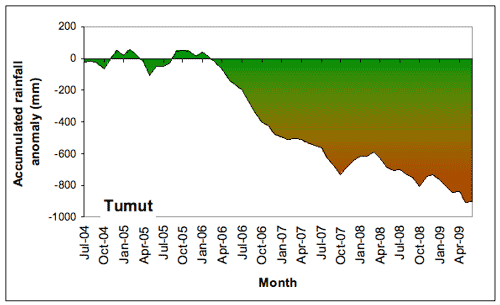Tumut
Please note: Text or data highlighted in this colour represent an update to this indicator for the period 2008/09. All rainfall figures have been updated on this page.
Rainfall Analysis
The main rainfall observing sites used in this analysis were Tumut - Wattle St (Bureau of Meteorology Station No. 072044), which commenced in 1886; and Cabramurra (No. 072091), which closed in 1999 and was replaced by an automatic weather station (AWS). Data from nearby stations were used to calculate values for months with missing data at these sites (see Appendix 2 for further information). However, there are problems in developing a high quality continuous dataset for Cabramurra because the relationship between rainfall at the manual observing station and at the AWS is not particularly strong, despite the two sites being in close proximity.
Note that in the following analyses rainfall totals for individual months or years (where the year is defined as the 12 months from July to June) are compared to the long-term average (or climatology) from 1961-1990. A 30-year period is used to calculate climatological averages to conform with World Meteorological Organisation practice; this takes into account year-to-year variations and less frequent events such as El Niño or La Niña. This particular 30-year period is used internationally as a standard climatological average period.
As shown in the table below, Cabramurra appears to have had around average rainfall during 2004/5 with generally below average rainfall for the other four years. Tumut was drier than average for all five years. The driest year at Cabramurra appears to have been 2006/7, when rainfall was around 33.4% below the long-term average. If the derived data set for Cabramurra can be considered as an indicator then 2006/7 was possibly one of the driest year on record for Cabramurra. At Tumut, the driest year was 2006/7 where rainfall was 45.2% below average. This was the second driest year on record for Tumut and would support the fact that Cabramurra also had one of its driest years on record. The wettest year in the last five years at Cabramurra appears to have been 2004/5 when rainfall was still 4.7% below average. At Tumut the wettest year was 2004/5 where rainfall was still 5.3% below average.
| Rainfall Statistics | Cabramurra | Tumut | ||||||||
|---|---|---|---|---|---|---|---|---|---|---|
2004/5 |
2005/6 |
2006/7 |
2007/8 |
2008/9 |
2004/5 |
2005/6 |
2006/7 |
2007/8 |
2008/9 |
|
| Annual Total* (mm) | 1554.5 |
1447.9 |
1087.0 |
1313.1 |
1437.6 |
770.0 |
695.6 |
445.1 |
659.2 |
627.4 |
| Anomaly (mm) | -76.4 |
-183.1 |
-543.9 |
-317.8 |
-193.3 |
-42.8 |
-117.2 |
-367.7 |
-153.6 |
-185.4 |
| Anomaly (%) | 4.7 |
-11.2 |
-33.4 |
-19.5 |
-11.9 |
-5.3 |
-14.4 |
-45.2 |
-18.9 |
-22.8 |
| Mean (1961-1990) (mm) | 1630.9 |
812.8 |
||||||||
*Note: annual totals were calculated for the 12 months July-June.
Monthly Rainfall, 2004-2009
A comparison of monthly rainfall totals with the long-term monthly average rainfall at Cabramurra and at Tumut (Figure 1a and b) shows that the first half of the period by around average rainfall except for the autumn of 2005 which was very dry with the period from early 2006 to 2008 being a time of generally below average rainfall with only isolated months of average or above average rainfall. The wettest months occurred in the first part of the period with very dry months during 2006/7. This prolonged period of below-average rainfall was associated with an El Niño event during 2006/7 while the wet months in late 2007 to early 2008 and November-December 2008 were a result of a La Niña event. Dry conditions returned for Autumn 2009.
a b |
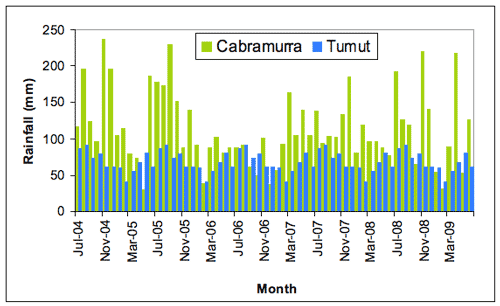 |
Of the 60 months in this period, 40 (67% of the record) had below-average rainfall at Tumut and from the derived data around 41 months (68%) at Cabramurra (Figure 3). The most prolonged dry spell in the region began in February 2006 and extended to October 2007. Throughout this period there were only four months of average or above average rainfall. This period reflects the impact of the El Niño event of 2006/7 on the region. The autumns of 2005, 2008 and 2009 were also particularly dry at both locations. The driest individual month at both stations appears to have been May 2005 with 2.2 mm at Tumut (long term average for May is 80.7 mm) and around 30 mm at Cabramurra (long term average for May is 168.9 mm).
Average or above average rainfall was only experienced at both locations in the periods November 2004 to February 2005, May to October 2005, November 2007 to March 2008 and November 2008 to April 2009. The wettest individual month at Tumut was September 2005 with 152 mm (long term average 73.2 mm) followed by November 2004 with 125.6 mm. These months appear to also have been the wettest months at Cabramurra with around 230 mm likely to have been recorded for both months, however as the data is derived it is difficult to say which was actually the wettest of the two. These months at Tumut were the 3rd highest September on record since 1886 and the 10th highest on record for November since 1886. Rainfall of around 230 mm at Cabramurra would put November 2004 in the top 3 or 4 wettest Novembers for Cabramurra on record since 1955.
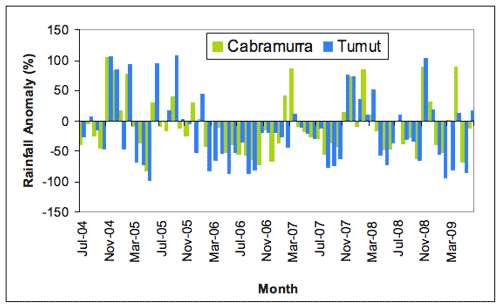 |
The results of the generally dry conditions during 2006/7 can be seen in Figure 4. Rainfall accumulation at both locations appear to have been just around the norm for 2000 and 2001 followed by a rapid increase in the rainfall deficit during 2006-2007 before flattening out in 2008. This increase in the rainfall deficit in 2006/7 again reflects the impact of the El Niño event over this period. The total accumulated monthly rainfall total at Tumut for this period was around 898.1 mm (110% of the Jul-Jun average) while at Cabramurra it was around 1325.2 mm (81% of the Jul-Jun average).
a
|
The climatological context for rainfall at Cabramurra and Tumut
The long-term perspective
As is typical of the region, Cabramurra and Tumut have experienced large fluctuations in annual (July-June) rainfall, including several extended periods of above- and below-average rainfall since records began (in 1886 at Tumut, and in 1955 at Cabramurra). In general, annual rainfall was lower and less variable early in the 20th century, followed by a period of greater variability. Rainfall variability has been lower since about 1980 (Figures 5 and 6). At Tumut, this recent dry period is similar to the dry periods experienced in the periods of the late 19th to early 20th Centuries and the late 1970’s to early 1980’s and therefore to this point in time can be considered as just part of the natural variation. At Cabramurra, it appears that the recent dry period is the driest on record, however records only commenced in 1955 and the trends in recent years must be used with caution as they are based on derived data and therefore only indicative. The fact that they mirror the trends in Tumut is suggestive that these trends are most likely.
- Rainfall in the late 19th and early 20th century was generally below average (to about 1915), followed by a short wet period in the late 1910s. Since then annual rainfall totals have been more variable, until the mid 1980s.
- Several wetter-than-normal years in the 1950s produced a generally wetter period then.
- A consistently drier period around 1980 was followed by slightly above-average rainfall until the early 1990s. Since about 1995 conditions have been generally drier than, or close to average.
The wettest year (July-June) on record at Tumut was 1955/6 (1421 mm); the driest year was 1928/9 (419 mm).
- The shorter record at Cabramurra means that the same analysis as above is not possible for this station. Nevertheless, the Cabramurra record clearly shows similarities with the longer Tumut record.
- Cabramurra was more consistently drier than average in the 1960s than was the case at Tumut; both stations were wetter than normal in the 1970s.
- The early 1980s were less consistently dry at Cabramurra than at Tumut, and the early 1990s period of above-average rainfall more strongly expressed at Cabramurra. Since 1996 conditions have been generally drier than average at this station, and more strongly than at Tumut.
- It is unlikely that these differences are a result of the different record lengths, since the long-term average against which the anomalies are calculated is that for the period 1961-1990 in both cases.
The wettest year (July-June) on record at Cabramurra was 1974/5 (2372 mm) while the driest year appears to have been 2002/3 with 2006/7 being not far behind. As these figures are derived values, it is not possible to actually select which may have been the record year.
![Figure 5. Annual (July-June) rainfall at Tumut from 1886/7 to 2008/9 depicted as deviations from the long-term mean. A 5-year running mean is superimposed to highlight wetter and drier periods. [Deviations were calculated as the difference between the rainfall for each year and the mean for the period 1961-1990 (scale in mm).]](../images/tumut/rain08.gif) |
![Figure 6. Annual (July-June) rainfall at Cabramurra from 1955/6 to 2008/9 depicted as deviations from the long-term mean. A 5-year running mean is superimposed to highlight wetter and drier periods. [Deviations were calculated as the difference between the rainfall for each year and the mean for the period 1961-1990 (scale in mm).]](../images/tumut/rain09.gif) |
The dry period that commenced in 2002 affected rainfall at both stations (figure 7). While there are differences in the accumulated rainfall deficit between the two sites, the rates at which the deficits accumulated were similar. The periods of most rapid accumulation of negative rainfall anomalies were 2002/03 and 2006/07, both of which were El Niño years. During this 9 year period there were 72 months (67%) of rainfall deficits at Tumut and around 68 months (63%) at Cabramurra. The total rainfall deficits over this period are around 1432.7 mm at Tumut (176% of Jul-Jun annual total) and around 1882.6 mm at Cabramurra (115% of Jul-Jun annual total).
a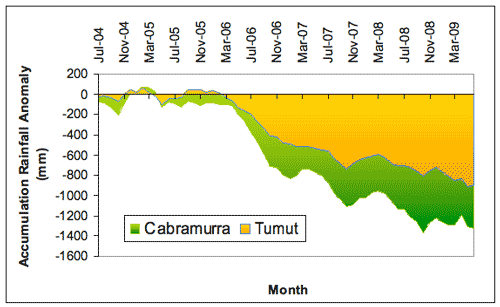 b b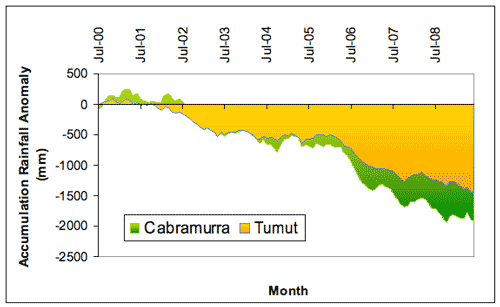 |
About the data
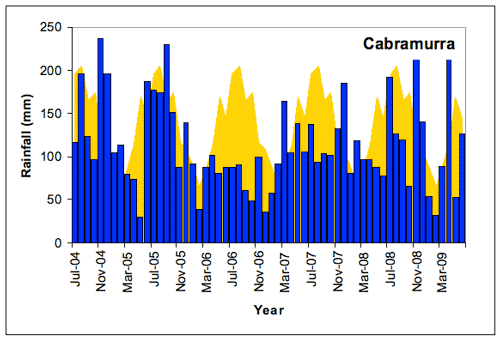
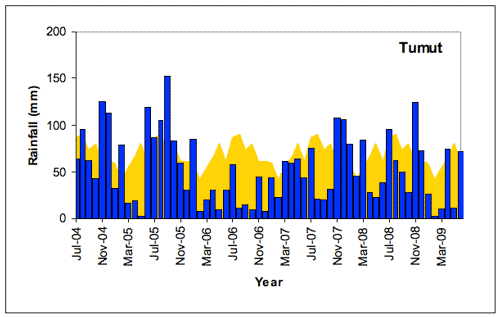
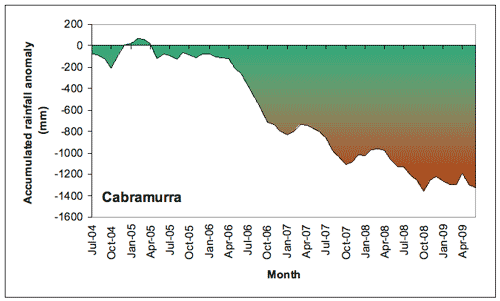 b
b